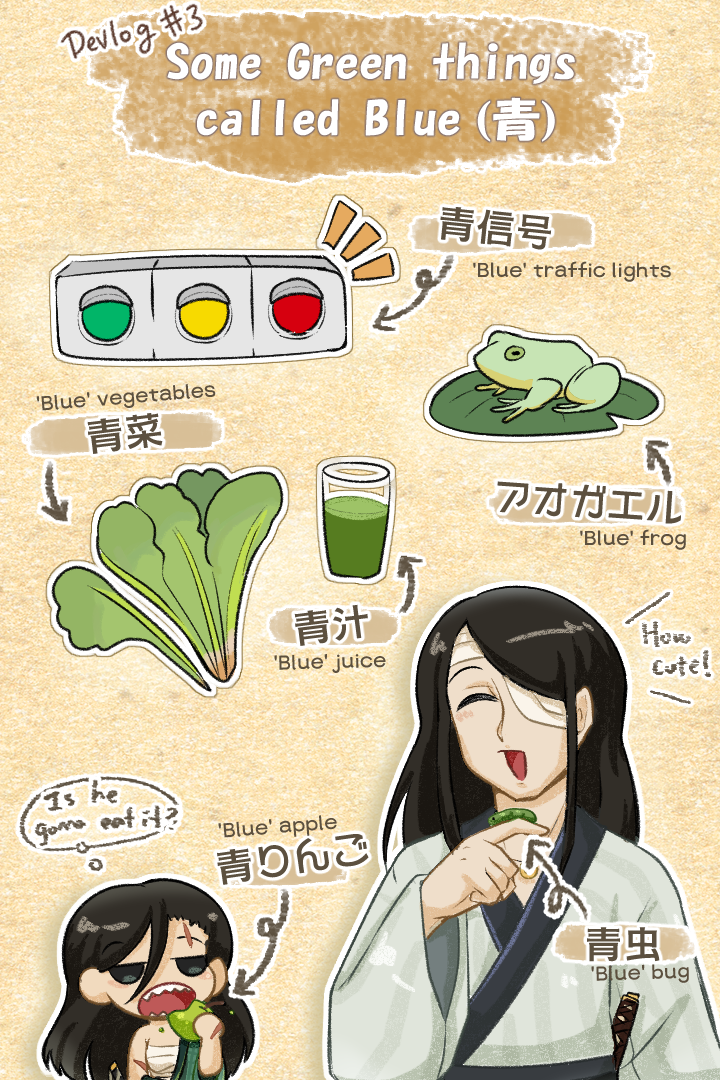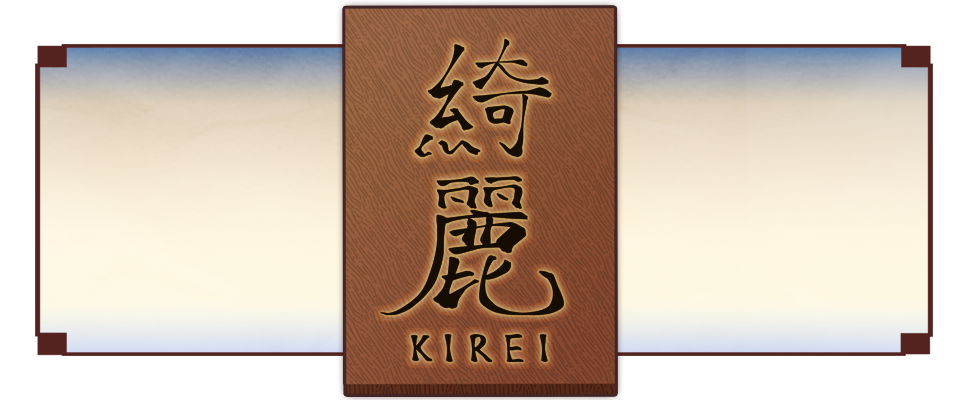Devlog #3: About Names (Human LI) ... And a bit on Colors

Hello! Happy Valentines, Happy White Day (only in Japan maybe. . .?) and Happy Everything That Went Past. This is Moku. . . Again! It took a bit longer than planned to post the next Devlog, but it’s here now, yay!Planning what to write about in advance really helped, who knew preparation was important. . .
Firstly, the important things; a quick game update. Since the last Devlog, the next two sections of the game have been coded (Thank you Elodie for the magic as always), and we (aka. Skai, it’s Skai. Bless Skai.) have been working on implementing the sprites and scenes. There is another scene with Nikko which uses the full screen that looks amazing as always; I really love the art and atmosphere for that bit, and hopefully everyone will like it too!
As always, thank you to the team and also, of course, you reading the Devlog for still sticking by whilst life can get so busy.
Going into the Devlog, this one will be on the names of the Human Love Interests, Ao and Midori. . . Or more, on colors itself.
In the game when Nikko learns about Ao’s name for the first time, Nikko and Tsuneha have a brief conversation about their name being ‘like the color’, with Tsuneha commenting its “wonderful names for a pair”, whilst Nikko just rolls her eyes. The only other comment given to the meaning of the names is Nikko noting its “green and green” matter of factly, since we thought further explanation would seem a bit out of place.
But a Devlog is a perfect placeI think to do that out-of-place further explanation, so this one is just for that!
The Human Love Interests
- Name: Ao
- Kanji/Japanese writing: あを
- Meaning: ‘Blue’
Ao and Midori’s name just came out of a casual conversation before we had character designs; ‘What if they’re just names Ao and Midori’ ‘Well, it works lol’. I personally thought Ao and Midori would be a fun name for twins since ‘Ao(青)’ is also used to refer to ‘green’ in Japanese, which I will go into a little more detail in a following section. Despite their coloring came after the name, I personally think their colors also match their personalities well. . . Funny how designs work! I say this like I designed them but the human love interests are Skai’s designs.
The ‘を’ in the name instead of a normal, hiragana ‘お’ is just to make it look a little fancier. It also does match the loose era the story is based on (around the Edo period), as ‘を’ in that time was read and used as ‘o’, despite ‘を’ being written as ‘Wo’ in modern day romanization.
In the context of the character, Ao chose his own current name for reasons that will be revealed in game (hopefully!), and also because it matches ‘Midori’; he found it as amusing as Tsuneha did, apparently.
-----------------------------------------------------------------------------------------------------------
- Name: Midori
- Kanji/Japanese writing: みどり
- Meaning: ‘Green’
The naming process was already described in Ao’s section, so there is actually not much to write here. . .
In the context of the character, Midori’s name is written fully in hiragana since she lived on the streets and did not have an education; Hiragana is a more basic form of writing than kanji, so it was easier to pick that up than all the million kanji Japanese have.
A Little Extra: About Blue (青) and Green (緑) in Japanese
Short story:
In the past, Japan used to call green (‘Midori’) things ‘blue (‘Ao’)’ as well, and there are still a few words that follow that tradition. Hence why Nikko’s comment upon learning the twin’s names was ‘Ao and Midori’ just. . . ‘Green and green, huh’.
Longer story. . . And more on the color ‘green’:
Some personal storytime; I was talking with a Japanese friend the other day and we bonded over accidently calling something ‘green’ as ‘blue’ in English– their example was the green traffic lights and mine was a green apple. In Japanese, these are called 青信号 (Ao-Shingō) and 青りんご (Ao-Ringo); literal translation being, ‘Blue traffic lights’ and ‘Blue apple’.
In Japanese, there are a few words like this where ‘blue (青/Ao)’ is used to refer to something ‘green’. This is thought to be traced back to old customs; in older Japanese, there were only four colors - red, black, blue and white (all colors that can be used as adjectives when an ‘I (い)’ is added to the end (extra fact if there are any language people out there)). As there were only four colors, everything was categorized into those four terms; referring back to old poems from around the 8th century, we can see greenery was called ‘blue’ and the ‘cool’ colors, including green, was generally was all lumped into being called ‘blue (青/Ao)’.
So, it was still a widespread, long custom to call some green things ‘blue (青/Ao)’ in Japanese, and that custom stayed in the language until modern day. Going back to the ‘青信号 (‘Blue’ traffic lights)’, it was called ‘green (緑) lights’ when it was first introduced in Japan, but in 1947, it was changed to be called ‘blue (青) lights’ in the Road Traffic Control Act set by the government (and it’s still called ‘青信号 (‘Blue’ traffic lights)’ in the modern day Road Traffic Act too).
However, this is not to say the color ‘green’ did not exist at all in the old Japanese language; by the 10th century, the word ‘green (緑/Midori)’ starts appearing in text to point to green things. Note, the word has been used to mean ‘blue’ as well, but generally used to point to green things (like summer leaves or grass), even in older text.
As all words, there are a number of theories on how the word itself was made. One is that the word came from ‘みずみずしい (Mizumizushi)’. It was used to describe things ‘fresh/new/young’ or ‘verdant/lush’, such as a new leaf. . . Hence, why it was used to point to things that are ‘green’ and likely why many green plants are referred to as ‘ao (青)’ as well. The use of ‘Midori (緑)’ in this context is still used in the Japanese language, such as the phrase ‘緑の黒髪 (Midori no Kurokami)’, which means ‘glossy (fresh), black hair’, but literally translates to ‘green black hair’. . . Perhaps Midori’s hair color wasn’t a coincidence. . .
Another theory which I found more interesting in the context of the game is that the word came from a bird. At this time, ‘green’ referred to dark green, as the color of the Sonidori (鴗鳥) - a old name for a Kingfisher. ‘Sonidori no (Of the Sonidori)’ was a set phrase in poems that was used with the word ‘Ao (Blue)’; together, it was ‘Blue of the Sonidori’, used to describe the color, for example in the poem below:
「鴗鳥の 青き御衣を まつぶさに 取り装ひ」(古事記)
'Sonidori no awoki mikeshi wo matsubusani toriyohiso (Carefully, I put on a robe, blue like the kingfisher)' (From 'Kojiki' - Japan’s oldest history/chronicle book)
This color is what would be closer to the modern day ‘green’ rather than the ‘blue’ it is being called. And so, another theory of the origin of the Japanese word ‘green’ - Midori - is that it came from ‘Sonidori’.
(Fun extra fact, there is another word that comes directly from the Kingfisher’s feathers (翠 (Midori)), but that word only came around the Meiji Era (19th~early 20th century).)
I didn’t know about this theory until looking it up, and didn’t really think of the kingfisher (翠) until writing this Dev Log, but it is funny how things have come full circle somehow. . .
Going off track of the story:
A.K.A. The part where someone without in-depth knowledge of the field rambles on about it because they read it for the first time and found it interesting. (Taken best with a grain of salt 🧂)
When looking for articles to read for this Devlog, I found out that the topic of ‘blue’ and ‘green’ seemed to be fairly common in the field of chromatics. One word that always seemed to come up was the ‘basic color terms’. Basic color terms are color terms that refer to the most salient color in that society - the word can represent a single hue, a single category, or merge what other cultures would call two different colors. As the language develops, the basic color terms it has expands; the theory (though debated upon, still highly referenced) is that the way basic color terms are added to a language all follow a similar pattern - ‘blue’ and ‘green’ being added as different terms is a proposed step in the development.
There also seems to be colors that are often put in the same category throughout different languages - green and blue being one of these (the ‘Grue’ motif) . This ‘Grue’ motif appearing is a fairly common phenomenon in languages. A good example of this near Japan would be in Chinese. In modern Chinese, 青 (qīng) means ‘green’ (like in ‘青草’ (qīngcǎo)), but can also be used to mean ‘blue’ (in ‘青天’ (qīngtiān)). Earlier on in history, the word seems to have been used for all cool colors (blue/green/black), perhaps like the Japanese history with the word ‘青 (Ao)’ (which historically, pointed at mainly cool colors too). (Note in modern day Chinese, 青 (qīng) doesn’t seem to be a basic color term, and instead broke into the three terms ( 籃 (blue), 緑 (green), black (黒) ).) Old English also went through a phase of having a color term that pointed to the ‘grue’ category until it started using different words for the two colors.
. . . This part doesn’t really have a conclusion since I just thought it was interesting that the color ‘blue’ and ‘green’ have historically been put into the same category in different languages as well, such a long history the colors have together. . .
Also I feel like I will start a war here since I do not speak Chinese nor do I know anything about color, please spare me. . . . . .
The actual end with no more side tracking, thank you for reading!

References used:
Bogushevskaya, V. (2015) '‘GRUE’ in Chinese: On the original meaning and evolution of qīng (青),' in Thinking Colours: Perception, Translation and Representation. Cambridge Scholars Publishing, pp. 26–44.
Kuriki, I., Lange, R., Muto, Y., Brown, A. M., Fukuda, K., Tokunaga, R., Lindsey, D. T., Uchikawa, K., & Shioiri, S. (2017). 'The modern Japanese color lexicon,' Journal of Vision, 17(3), p. 1-18.
Lindsey, D.T. and Brown, A.M. (2009) 'World Color Survey color naming reveals universal motifs and their within-language diversity,' Proceedings of the National Academy of Sciences, 106(47), pp. 19785–19790.
須賀川誠三 (2001) 'C.P. Biggam, Blue in Old English: An Interdisciplinary Semantic Study, Rodopi, 1997., 333pp.,' 英文学研究, 78(1), pp. 69–72.
高宮和彦 (1991) '食物の配色,' 食生活総合研究会誌, 1(1), pp. 52–56.
川上徹也氏, 春仲萌絵 (2023) '日本語の色の語源は? 【ことばのふしぎ大冒険6】第2話 緑色なのになぜ「青信号」とよぶの?(3)', コクリコ|講談社. https://cocreco.kodansha.co.jp/cocreco/general/education/wGTks.
なぜ信号機は赤黄緑の3色が使われているのか教えてください。. https://jaf.or.jp/common/kuruma-qa/category-drive/subcategory-sign/faq166.
栗木一郎 (2019) 'なぜ「青」信号と呼ぶのか?―青と緑と,色カテゴリーの分離の話―,' VISION, 31(4), pp. 114–116. https://doi.org/10.24636/vision.31.4_114.
小柿孝徳 (2024) 中緑(なかみどり)とは?:伝統色のいろは. https://irocore.com/nakamidori/
小柿孝徳 (2024) 緑(みどり)とは?:伝統色のいろは. https://irocore.com/midori/
(I couldn't figure out how to do footnotes, so feel free to ask if you are interested in knowing which part came from which specific document. . .!)
Get Kirei (綺麗)
Kirei (綺麗)
"If one day I lost these feathered limbs, would I then be beautiful?"
| Status | In development |
| Authors | skai2blue4u, Moku |
| Genre | Visual Novel |
| Tags | Amare, Fantasy, Female Protagonist, Folklore, japanese, Otome, Story Rich, ukiyo-e |
| Languages | English |
More posts
- Devlog #2: About Names (Title + MC)Jan 09, 2025
- Devlog #1: Vision and InceptionJul 10, 2024
- A Word From the TeamJul 01, 2024

Leave a comment
Log in with itch.io to leave a comment.